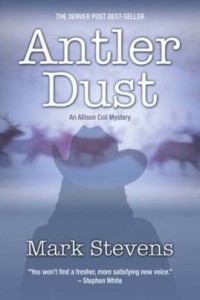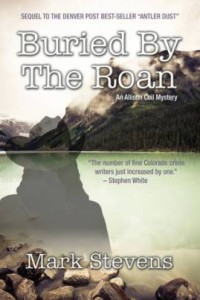Mark Stevens is another one of those Colorado authors I love to talk about. As member and Program Chair of Rocky Mountain Fiction Writers, he already has a big job putting together together the excellent monthly programs for RMFW. On top of that, he has a real job in the real world (as opposed to the writing world which is surreal). And in his spare time, he writes mysteries.
Antler Dust is a top notch story with a well-drawn protagonist. I’m looking forward to another good read in Buried by the Roan.
————————-
Writing a Sequel by Mark Stevens, Guest Blogger
 Writing a sequel scared me to the deep, dark core.
Writing a sequel scared me to the deep, dark core.
The process was a mystery.
How would I make sure my main character changed but…stayed consistent?
How would I keep the story moving…and not let it bog down in back story?
For the two or three people out there who have not yet read Antler’s Dust how would I explain how the central protagonist, hunting guide Allison Coil, came to live in the Flat Tops Wilderness?
And (gulp, gasp, ack) what would I do for a plot that would be different…but not too different?
I didn’t have much of a choice. Readers seemed to respond to Allison. She’s tough. She’s outdoorsy. She’s fearless. (I was about to have her back shoulder inked in a dragon tattoo, but then, oh well. Never mind.)
 So I needed to bring her back. Okay, well, the truth: I liked her. I wanted to keep her around, too. I wanted to throw some more trouble her way and see how she handled it.
So I needed to bring her back. Okay, well, the truth: I liked her. I wanted to keep her around, too. I wanted to throw some more trouble her way and see how she handled it.
So, what’s a writer to do? How about start with the masters?
Like Nevada Barr, Lee Child, Stephen Hamilton or Ruth Rendell?
I studied. I read. I studied some more. If you read a mystery novel with this particular issue in mind, you notice that most of the character information in a sequel (drum roll, please) comes through character revelations. I tend to prefer writers who don’t put a “stop” sign in the middle of the plot and halt for a few paragraphs (or pages) of background. Those stop signs are like the writer pressing “pause” on the movie projector and stepping out into a spotlight by the stage and saying, “before we go on, you need to know about this one thing that happened to her (or him) back when our hero (or heroine) was a naïve child.” (Or something to that effect).
I like stories that slip this information into your head as deftly as a new, hidden tax on your cell phone bill. I like the information subtle. I want it feathered in. I want just enough, no more.
I’m not saying it’s easy. It’s still so utterly tempting to put up the stop sign and let the back-story spill. But I noticed with Barr, Child, Hamilton & Rendell that they trust the reader. They might mention a few key details, but they don’t whack you over the head with a cast-iron frying pan. If anything, the good ones err on the side of too little information.
And then it occurred to me that my favorite television shows—the episodic ones—don’t spend a moment on back story. Think about it.
(I’m going to show my age here, but still, think about it.)
Kojak. Columbo. Perry Mason. Hawaii 5-0 (Jack Lord style).
 These are episodes involving the same character and the back-story is just a fact of life for those who might want to dig deeper or start with the pilot.
These are episodes involving the same character and the back-story is just a fact of life for those who might want to dig deeper or start with the pilot.
Most readers want story, which means that the events keep moving. Less back-story quicksand, more grease. More action. They want a reason to turn the page, not reach for the No-Doz.
So I plunged ahead. The result is the sequel, Buried by the Roan. It sends Allison into the fray over fracking (hydraulic fracturing for natural gas) and a neighborly (i.e., bitter) land-grab case using a little-known Colorado law called “adverse possession.”
She is still Allison.
There’s a bit of “old” information.
I tried to weave it in so it’s not too obvious.
Most of all, I tried to keep Allison moving and thinking, being herself.
————————-
Mark, thanks so much for being my guest today. As you know, fracking is a major topic of discussion in my corner of Northern Colorado. Hardly a day goes by without a new article in the paper detailing the debates and protests. Buried by the Roan should be a bestseller in this part of the country.
For a list of Mark’s upcoming appearances, visit the Events page of his website. You can also find a short synopsis of each book and an excellent bunch of reviews.






Good post!
Though I am not writing a sequel right now, I plan to do so next year, so this is also very relevant in my case.
And I think the lesson learnt from the TV series is very important. I know that as a reader I´ll rather be treated like an intelligent person who can figure some things out on my own than being told everything in great detail. So when I write, I try to write for myself by only giving background information when it is absolutely necessary.
Just wanted to stop by and say “thanks” all for the lively back-and-forth and also to Pat for hosting. When you have friends and supporters like Pat, you can’t go wrong. Much, much appreciated!
Well alrighty then…two more books on the “to read” list. Interesting interview. Thanks Pat.
Excellent information, Mark. You answered things I’ve often thought about. Thanks for posting.
Pat – thanks for inviting Mark.
That makes for a good discussion. I considered my second Sylvia and Willie book a sequel because I wasn’t sure I’d write any more of them. Maybe some of us don’t get in the “series” mindset until we have our third book in mind.
Mark, I know you’ll be off to do other things this evening, so I want to take this opportunity to thank you for being here today. I’ll see you at Colorado Gold.
That’s an interesting distinction, Terry…or at least your comment made me wonder if there IS a distinction between a mystery “series” and a “sequel.” I like to think of books as sequels because I think of character development for the central protagonist, not just “another episode” for a crime fighter. Are all of Sue Grafton’s A-Z books truly sequels? Guess I need a dictionary…
The publisher of my Blackthorne, Inc. series doesn’t contract multi-book deals (at least not normally) so I’ve written all mine as ‘connected books’ rather than true sequels. However, with my Pine Hills romantic suspense, since I was totally unaware that one “can’t” have a true sequel in romance, I did write one with the same protagonists. But since I hate spoilers, I did my best to avoid having a reader bored with back story if they’d read the first book, while making an effort to let readers read them out of order.
Terry
Terry’s Place
Romance with a Twist–of Mystery
I wonder if you have to trick yourself into thinking that you are writing a stand-alone every time you write a sequel. I just read the new S.J. Rozan (“On the Line”) and it was a page-turner from the opening paragraph and yet is a “Bill Smith/Lydia Chin” mystery…one of many in the series. If you picked this up first, you would nothing about them. It’s primarily Bill Smith’s story but he never slows down to tell you anything about himself or his background. S.J. are you out there? Any thoughts on this?
Mark, you are so spot on with these issues. I just started writing the 3rd book in my urban fantasy series and tried weaving in small bits of backstory at the beginning to which my agent said, “No.” Oops. She said it resulted in “uneven pacing” and now I’m refocused on writing it as if it was the first book instead of the 3rd. The 2nd book didn’t give me this headache. What’s up with #3? Argh.
My second novel was tough, but I listened to what my readers wanted and provided only tidbits of backstory. Hopefully I succeeded.
Thanks for the early feedback! I was happy to have a great review from the Grand Junction Sentinel from a reviewer who had read both books and he really “gets” Allison Coil, if you know what I mean. That review is behind a “pay wall” on the Internet but I’ve posted it on my web site under the “reviews” section at http://www.writermarkstevens.com
Love this, Mark: “I like stories that slip this information into your head as deftly as a new, hidden tax on your cell phone bill.”
It’s a real trick, and not everyone does it right. Except maybe T-Mobile. . . . and Mark Stevens.
Thanks for the great comments, ladies. I’m another one who balks at reading long passages of back story or pages and pages of info dump. Still, we often need that information to understand the story. It’s hard to get it just right.
I agree – a stop sign and info dump can make me stop reading. I like it woven in throughout too 🙂
Mark – I think you are so right! It is like lots of things in writing – I often have my first readers say ‘but I don’t know what fracking is?’ or some such thing – and I say, ‘good, I’m sure you’ll find a way to figure it out’ We need to not leave them frustrated but challenged.
And even though I live in Nova Scotia – fracking is in the news here too!
I think your idea about not having an obvious back story in your sequel holds true for any novel, stand alone or series. Back story is such an easy thing to get caught up in that it can sink a lot of writers without them realizing it.
Best of luck to you, Mark! And thank you, Patricia, for hosting him. Best of luck to you too!
Pat – Thanks for hosting Mark.
Mark – That’s the tricky balance in sequels, isn’t it – how to create new situations and have the characters grow and develop, but still be who they are. I respect the way you researched and thought about it all before you plunged in and wrote. I wish you much success!